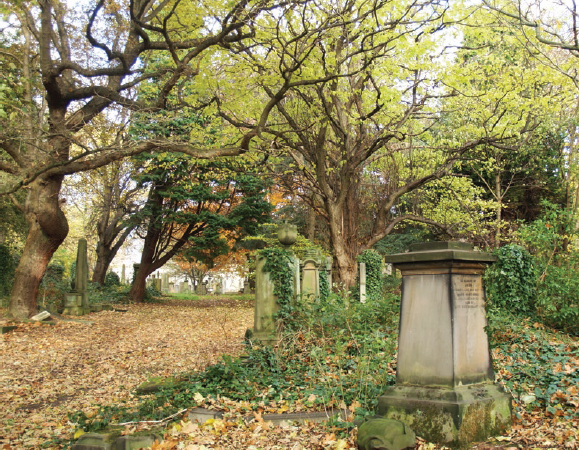
IN A MELODIC, South Carolina, Lowcountry brogue, Bennett Baxely ticks off the plants his mother used to collect: “Mother would pull fetterbush from the swamps. She contended that you could pleasantly shrub a yard with flowering things from the woods. Sarvisberry, pearlbush, chokeberry, and Black Thomas grape, son of the muscadine; it is the best for eating and pies.” He sings, “She nevah boughta’ thing.”
He could be talking about himself or me or a million others who are so inspired by the woods that we just want to be a part of them, to have a part of them always growing right out the back door. It wasn’t all too long ago that nursery centers were quite rare and most people knew how to start their own plants from seed, cuttings, or divisions. There were no garden centers because there weren’t yet any plastic pots for cash and carry. Sure, we’ve always had nurseries, but they were mostly field nurseries where plants were grown in the ground and shipped bare root. And while famous places such as Pomeria or Fruitland’s Nurseries offered an astounding 1300 different plants thirty years before the Civil War, most nurseries focused on fruits, nuts, and bare root trees.
What plants wait to be resurrected in cemeteries? As plants go in and out of fashion in the nurseries and gardens, cemetery plantings tend to stay the same. So besides being intriguing places to explore, old cemeteries are repositories for old-timey plants.
The rapidity with which this has all changed since then has been astounding. Buying plants is now an established part of our consumer culture. Supply-chain retail stores and their glitzy marketing have even, for the most part, usurped nurseries. With so many plants now available at our fingertips, and marketed in gas station displays and grocery stores, it’s tough to remember the time when this wasn’t the case. Granted, I’ve sure enjoyed easily available plants. As a nursery owner, I make money from plants that I start and grow, as well as plants that I buy and sell, and as a garden curator and designer, I’ve bought from and supported nurseries all over the world.
But as a gardener, a thrifty man, and someone who loves to trade a good story, I’ve been seeking out and sharing free plants for most of my life. When I was a boy, one of my favorite treasure troves to plunder was the dump outside of our local cemetery. While my parents were busy in the cemetery tending to our family plots, I scouted for potted chrysanthemums and Jerusalem cherries, and old bulbs, that had made their way from the graves to the dump, to take home. I loved the old metal wreath holders, too, but my parents wouldn’t allow me to take them. I think perhaps they thought they were too morbid. After the dump, I also loved to scour the woods, along with abandoned home sites and old gardens. I still have a giant wild azalea that I dug up while we were out fishing. I didn’t even realize until I was in college that we had two world-renowned nurseries nearby. Plants grown by my friends, mentors, and peers, and collected during hikes and on vacations—I still make visits to local cemeteries whenever I’m traveling—make up most of my scrapbook garden. Scavenging plants and finding plants for free or cheap can quickly become an obsessive hobby.
Crinum lilies are sometimes called cemetery lilies. They are tenacious, long lived, and traditionally planted as memorials. Before I collect plants, I get permission and check to be sure I’m not taking home any pests.
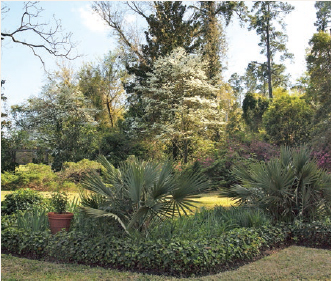
Bennett Baxely’s Lowcountry garden, “pleasantly shrubbed from the woods.” Here, dogwood and dwarf palmetto coexist in zigzag ivy beds
It can become a profession, too. Obsessed visionaries kick around the world in forests and hard-to-get-to villages; without them, we wouldn’t have such things as disease-resistant wheat, which was introduced to us by Russian botanist Nikolai Vavilov. An American counterpart, David Fairchild, the first USDA director, scavenged the world for plants, bringing back and selecting new varieties on which were later built the soybean, pistachio, and avocado industries, among others. Nor would we have many of our spectacular garden plants. But it was self-taught gardeners who brought us Christmas poinsettias and summer gardenias and the white-flowering American wisteria. More and more gardeners are going back into the woods looking for plants and new forms of old plants.
While any of us can do this, too, it is important to have a solid understanding of what you’ll be able to make grow, or whether or not you can find someone who can. Scavenging is not hoarding; scavengers need to know their needs, limits, and propagation techniques. I’ve included this chapter later in the book for exactly those reasons. It takes a true gardener to make a great scavenger; we keep dirt, plants, and stories alive to pass on to others.
The Teacher
BENNETT BAXELY
Bennett Baxely once told me, “I never even went into a nursery until the late 1950s, when someone opened one in Summerville,” about seventy miles away from his home. Fifty years earlier, Bennett’s parents started their home, farm, and gardens near Hemingway, South Carolina.
In the spring of 1920, Bennett’s parents made their little homestead on a modest piece of unamended land along Hog Crawl Creek, which is near Black Mingo Creek—let’s just say it’s way out in the lowland swamps of South Carolina. They relied on their land to produce almost all the food needed to feed the family and the farmhands. As times changed and food could more easily be bought, they expanded their flower gardens. Walking me through his garden, Bennett recalls:
The pasture originally came up to right here, 20 acres of horses and cows right in front of the house. Daddy planted his tobacco beds out here. But when he’d go away on hunting trips, mother would inch the fence back, imperceptibly, away from the house until, finally, that’s where she wanted the garden to be. So the garden eventually moved to this line.
Over the following decades, shrubs and other garden plants took over everything that used to be their farm. Almost none of the ever-growing assortment of shrubs was bought. Today, a low brick wall marks that fence line that his mother moved. It’s still a transition from the front lawn to a slightly more wild azalea garden. The garden that now completely surrounds the little farmhouse is so old-school cool, so layered, that Garden Design magazine gave it their Golden Trowel Award. It should tell you something that a modern magazine, with page after page advertising the newest and hippest in gardening, would still find room to honor a garden of scavenged plants and porch rockers with twisted cornhusk seats.
Bennett with his pass-along roses. The pale rose on the left has been in his family since 1900, and he says, “not even Ruth Knopf knows what it really is.”
One of the many beautiful plants that you’ll find growing there is Achimenes. While its common name is up for debate—be it widows tears, hot water plant, or magic flower—Bennett insists on the scientific name; that’s how he learned it when he first met this plant. He’s kept his going on his farm and garden, where he’s always lived, except for a brief stint as principal of the Daufuskie Island School, made famous in Pat Conroy’s The Water is Wide. There he met Mrs. Fripp, a 100-year-old local gardener, who gave him a few of the wormy little rhizomes of Achimenes. Now, every summer, he has buckets of pink, purple, and white trumpets overflowing in pots or spilling out of Kimberly ferns. They rarely need water. In late fall, every year since they were passed on to him, he sifts through pots to find the tiny rhizomes. He puts them in envelopes, a few of which are set aside for his garden next year and a few to be passed along as gifts with the story of Mrs. Fripp from Bluffton.
Bennett knows I enjoy his circular stories. He’ll start out talking about some vine he pulled up from the swamp, then move the story seamlessly to taking a freighter bound for Tangiers and sleeping in a churchyard in Kenya and ending up a decade later with a visitor dropping by who’s connected to all of those places and the very same vine. I can listen to his stories and be in his garden endlessly—they are intimately connected. So I’m intrigued on a summer walk when he says, “Come and see! The cartwheel lilies are in bloom!” I scratch my head; Bennett knows I love lilies and am especially intrigued by the ones that grow in the flooded cypress swamps around here. From black water that looks thick with mosquito larvae, snakes, and alligators, delicate white petals, 6 inches across, emerge. Below, the big bulbs hold themselves in cypress knees and muck. It’s mostly only collectors that get to see these bog plants, of the genus Crinum or Hymenocallis, that the locals call swamp bells or spider lilies. But in all my experience, I’ve never heard anyone use the term cartwheel lily, so when we round the corner toward a clump of old swamp bells, I call him on it: “I’ve never, ever heard you call them that.” With a sly grin on his face knowing he got me, he replies, “I’ve never called them that before, but don’t they look like someone doing a cartwheel?”
Bennett got his first Achemines, planted here in front of a building that was once a commissary for farm workers, in 1960 from Mrs. Fripp, a 100-year-old gardener in Bluffton, South Carolina.
Bennett, his parents, and my parents lived in a world where pulling some swamp lilies out of the ground to take home was perfectly acceptable. When I was little, it seemed like every adult I knew carried a little folding shovel in the trunk. Lots and lots of gardens were shrubbed with wild plants dug up off a ditch bank. More than just scavengers, these gardeners found, propagated, and introduced some of the horticulture world’s best selections of plants. In flood lands along southeastern rivers, our American wisteria is spectacular in spring, and it fixes nitrogen all year long. The white form, Wisteria macrostachya ‘Clara Mack’, is a favorite of mine, and it came from another woman who bushwhacked in southern swamps in the 1950s, saving and making several important selections of local plants. The wisteria is said to have been growing in the ruins of a once grand plantation. A yard worker there recognized it as unique and brought a piece to Miss Mac, who grew it for decades. In the 1980s, botanist Mike Creel determined that it was a rare white form of the somewhat elusive blue-flowered W. macrostachya. He scavenged a piece of it and introduced it to horticultural trade.
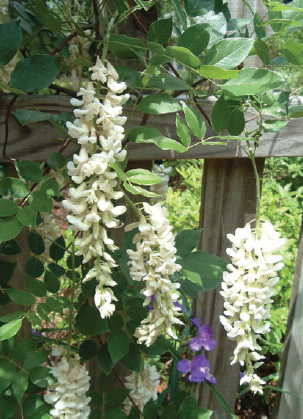
Wisteria macrostachya ‘Clara Mack’ is a sort of small-growing, unique, white cultivar of the Carolina wisteria. It’s path into cultivation includes scavenging by many people of various races and classes.
In the 1940s and 50s, new and improved cars and roads got people deeper into the wilds, into places where great plants waited to be discovered. Mary Henry, a Pennsylvanian, is another who embodies the tradition of the self-taught, adventurous plant collectors of the 1950s. Mrs. Henry made long, strategic plant-scouting road trips from Pennsylvania through the South. By her upbringing, she should have remained in Philadelphia ballrooms, but, as she once said (as quoted in the horticultural magazine Arnoldia in 1950):
Rare and beautiful plants can be found in places that are difficult of access…. Often one has to shove one’s self through or wriggle under briars, with awkward results to clothing…. Wading, usually barelegged, through countless rattlesnake-infested swamps adds immensely to the interest of the day’s work.
While collecting in Coweta County, Georgia, in 1954, she found a richly colored sweetspire (Itea virginica) shrub. She took that little plant on a journey through lots of hands and decades, and back north, and the Henry Foundation for Botanical Research distributed it. In the 1980s, that plant took an amazing journey through the hands of a series of famed horticulturists; Michael Dirr, of the University of Georgia, saw it at Swarthmore College and suggested to Judy Zuk, the director of the Swarthmore’s arboretum, that it be named and introduced. Woodlanders Nursery of South Carolina took the challenge, naming it initially as ‘Select Form’ and then as ‘Henry’s Garnet’ in its 1986–87 catalog. ‘Henry’s Garnet’ went on to become a poster child for the fledgling native plant movement.
Had Bennett and Mrs. Henry met, I’m sure they would have struck up a lifelong friendship, exchanging letters and plants for decades. It’s almost a surprise that they didn’t; if you ask around the area for the best person to talk to about local plants, everyone would point you to Bennett. You could then experience the same slow and leisurely drive to his garden that I enjoyed. After driving for miles on a two-lane paved road, sprawling fields on all sides, past Scott’s, a gas station and barbecue joint where they cut meat on retrofitted, stainless-steel surgery carts, you’ll turn off the paved road, on down the long, sandy lane. Tall pines and scrubby underbrush surround you on each side and, ahead, a white, dipped-in-the-middle picket gate and weathered rocking chairs call out to you from the farmhouse porch. The gate is a kind of joke, a garden folly. Just as you drive up, the dirt lane cuts abruptly left, going by the barn and into the backyard. There is no front door or front gate formality here; it’s comfortable and calm. We round into the backyard to find a few ladies leaving, bidding goodbye to Bennett, their tour guide and host. It’s a funny place to see a tour group.
Seeing these visitors, I’m immediately reminded of my grandmothers. Thin, blue-haired ladies, full of delight, probably saying something like, “What a gra-and day!” Their goodbyes and thank-yous are repeated, extended. Everyone is standing under a low-branched pecan tree, where the garden tour ended—and just where it had started. Here, where visitors arrive and depart, simple, low ivy beds get all the attention. The beds are almost mod: glossy, black-green ivy mounds kept in a cleanly repeating line, in stark contrast to the flat, apple-green centipede lawn. But the zigzag ivy beds mark a very important historic definition: the line between what used to be the yard and what used to be the vegetable garden. The jagged pattern was left when the 100-year-old split-rail fence finally rotted away. Ivy then took over, and Bennett pruned it. That’s the magic of Bennett and his approach to the garden: deep layers and swirling stories, all charmingly simple.
The older shrubs and trees around Bennett’s garden were scavenged from the woods by his mother, while he picked up many of the perennials and container plants on his travels.
Buicks crank and creep down the lane. Bennett is ready for us, his next visitors, though he is still waving goodbye with his white hair wisping in a breeze, his blue oxford a little damp. But he’s ready to do it all again, to tell us stories of each and every plant, not just the wild ones brought from the woods. While admiring an azalea in his yard, Bennett and I realize that we share a connection through that plant. He tells me about his mother embarrassing him as a boy, on a tour of the South Carolina State House grounds, back in the 1950s. She carried a little knife, and as they walked the grounds, she’d slip cuttings from the bushes into her purse, appalling him. He reprimanded her after the tour, “What if you got caught? That was stealing!” Listening to that story, I realize that this azalea is a cutting of a plant my great uncle planted when he was horticulturist at the State House in the 1940s through early 60s. He was known as a man who would break off pieces of plants for visitors to take home and root. I know he would smile to hear that I ran into some of his plants yet thriving half a century later. And the image of Mrs. Jesse James Baxely, Bennett’s mother, sliding cuttings into her old Sears purse makes me smile, too.
Updates and Adaptations
Most people don’t ride around today with a trunk full of shovels. Our hobbies have changed. It’s not even that common anymore to see kids running off to spend all day in the woods. But I think the same urges are still there. Whether you’re from the country, the city, or the suburbs, you can still learn to scavenge, even if it sometimes takes different forms. You’ll find opportunities in the woods, behind grocery stores, or in empty lots in Philadelphia. The drive is the same: to kick through poison ivy, climb cliffs, wade in mud and ticks, find cool plants and be with them in the wild. In doing so, we find each other and often ourselves.
There are other cultural shifts that have also made plant collecting less common, for better or worse. The days of stomping through someone else’s swamp and digging up their plants are over. Property rights, conservation issues, and plant protection laws—or at least the enforcement of them—in a more populated world have changed. Now you have to ask for permission. And if you’re going to get something from the woods, go for seed or only a cutting. Collecting from the wild now comes with a professional rulebook addressing ethics and conservation. There’s actually a voluntary International Code of Conduct for Plant Collectors, and a slew of organizations offer their own in extended, formalized, contractual language based on one simple message: be respectful. A respect for wild plants is crucial; it’s important to realize that every day we’re impacting the natural world in ways that we’d never imagined. It wasn’t even that long ago that we never would have considered that our actions might cause the extinction of entire species of plants or animals. Now we need to know better.
After collecting, let the plants recover to their original state. If there is more than one person collecting at the same site (whether you know it or not), the original state will be different for each collector. If you’re unsure whether anyone has been there before, or if there is evidence suggesting that they have, it’s best to avoid collecting anything at all. Keep in mind that for some species—for example, some ferns, Orchidaceae and Liliaceae in particular—ten years might be required for the population to recover fully.
Cordgrass and yaupon holly along the lagoon at Hunting Island, South Carolina. Both plants are used extensively in gardens and have been used as edibles, crafts, and pass-along plants.
Scavenging from cultivated and waste places is a little different; it involves respect for privacy and ownership. Shack botany is the term used for scavenging from abandoned cultivated places. There are many formalized groups you can join up with to do it. Working within a group can be fun and help you find great sites and meet like-minded people. Rose rustlers like Ruth Knoph spend their Saturdays scouting farmsteads, cemeteries, and ditches for old roses. The daffodil people rabidly rescue, too. Since bulbs hide most of the year, daffodil hunters have to rely a bit more on technology, using GPS and community-shared computerized maps. (You can find many of their tales and tricks in The Daffodil Journal, a quarterly magazine published by the American Daffodil Society.) Sometimes, these daffodil freaks even operate in reverse, taking bulbs back to roadsides and old home sites to help re-create their romantic visions. Learn from group experiences and don’t be dissuaded by the thought that all the good stuff is gone. Plant resilience and ephemeral nature mean that you can go to the same place on a different day and see totally different plants to scavenge. Whether you do it alone or in a group, beware of the plants you’re dealing with: what might be a sweet, scraggly rose or single daisy in a field in the wild might be a monster in your garden’s healthy soil.
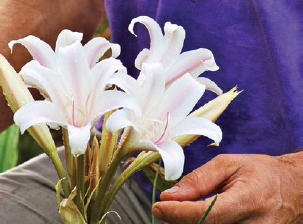
‘Regina’s Disco Lounge’ is a found crinum with a pale pink stripe.
A few years ago, while wandering around her little hometown, my mother took a few cuttings of a rose she spotted near the abandoned Brunson Laundry. As shown in chapter 5, Gloria is a great rooter; she’s also a great collector. Against the laundry’s brick wall, with terrible soil and no water, it was a little rose bush with tiny white flowers. Gloria rooted it and planted it right in the vegetable garden. For the most part, Gloria prefers to collect in old gardens, where the owners can tell her a bit about their plants and share stories and cuttings. Otherwise, as with that tiny rose, you never really know what you’re getting. Unfortunately, that rose soon revealed its inner monster, covering the entire fence where we normally grow cucumbers. We later identified it as ‘Alberic Barbier’, which can reach 60 feet tall with trunks 6 inches around. Getting rid of that freebie cost us a few days’ worth of prickly work. Worse are the things you collect and can never get rid off.
Seeds can be more difficult to deal with: even after you realize you’ve collected a weed, they come up for years. For a while, some friends and I collected the spectacular, fuchsia or red-flowered annual Flora’s paintbrush (Emilia coccinea) in central Florida. We quickly grew dozens of them with pride, but by July, they were flowering bright fuchsia in every bed, in every sidewalk crack, and worse, in the pastel perennial border, totally ruining the color scheme. Since then, I’ve found Emilia in orange, red, and yellow, and I now don’t care as much (or at all) about color schemes, so I grow them all. I’ve collected Carolina aster, saltbush, and camphorweed, which has the smelly scientific name of Pluchea, along with Packera tomentosa, a new favorite weedy aster with tiny hosta-like leaves, also known as butterweed. These are all invasive native plants that spread aggressively by seed. If you don’t realize this in time, you might as well get used to pulling up seedlings because these spectacular wildflowers make millions of seeds that will never stop coming up in the garden.
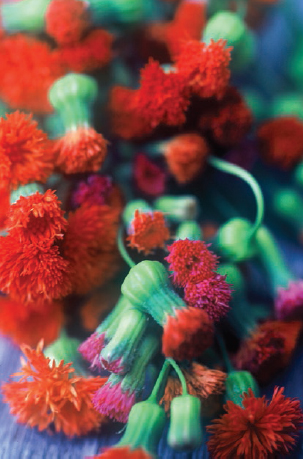
Flora’s paintbrush thrives in harsh environs throughout the tropics. It will seed itself in and is easy to share.
With these caveats in mind, scavenging still thrills and builds intriguing, personal gardens. It doesn’t have to be complex, time consuming, or even dirty. And if you don’t have time or desire for any of this fieldwork, you can stop by and scavenge at your local grocery store. The florist section has been a good source of chrysanthemums for me. I buy the cut flowers, root them, and plant them in the garden. They don’t all work out, though; many neon-colored mums that you see are actually white mums that are spray painted. And I don’t mean lightly spray painted, as you might have seen a florist do, but spray-on-tan painted, so they appear uniformly bright yellow, pink, or green. You can scratch that off to reveal white-petaled mums, and some, especially the big, floppy spider types, will grow outside, but they get mildew and don’t make great garden plants. Another caveat is that cut flower stems are totally desiccated, so they won’t root easily. I always cut away the ends or soak the entire cutting in water for a few hours before I root them, using the middle, which is still most likely to be turgid and rootable. Lemongrass, rosemary, and basil will all root, too.
Elephant garlic bulbs ready to go into the ground.
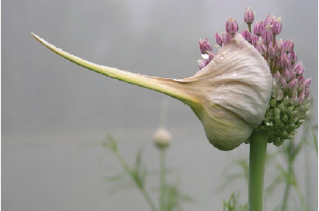
Elephant garlic just beginning to flower in May.
In the fall, the grocery store is also my go-to source for elephant garlic, one of my favorite, stately, and useful garden bulbs. In the South, we can’t grow giant, brilliant purple alliums like ‘Lucille Ball’, but elephant garlic is a great substitute. In gardens, I use this reliable, perennial allium mixed into flower borders. In containers, I mix it with narcissus or pansies or seed in a pack of radish. Once, in need of thousands of bulbs, I wound up buying from a restaurant supplier. Planted in fall, thick, steel gray leaves emerge for winter. In mid-May, giant, bouncy, lavender flowers are topped with a tiny jester’s cap. Still, almost no bulb companies sell elephant garlic. You might find plants adapted to your climate are best discovered on the produce aisle.
Potatoes are another great underground crop that you can get from your grocery store. In our climate, we plant potatoes around Valentine’s Day when our soil temperatures start to reach 50°F, which is the optimum conditions for starting potatoes. Pick up the cute new purple ones, golden fingerlings, and tiny reds, and cut them in half or quarters, leaving one of the eyes (which is sort of a dark spot or sprout). Let them sit a few days and then plant them in a bed with your pansies. As the pansies fade in the heat, the potato vines will scramble around. They add a dark, elegant green to spring gardens, but they quickly fade or get chewed up by beetles. After that, it’s time to dig them up and eat. There is, however, a caveat here, as well. Remember when potatoes used to sprout in the bag? Now many things in the grocery are sprayed with growth retardants for longer shelf life. Those synthetic chemicals will keep plants from growing in your garden, too. It’s not always necessary, but to be safe and insure successful gardening, I always scavenge from the organic section. The grocery store garden list can go on and on. Try things, test things, and discover the fun of grocery store scavenging for yourself.
You probably know the old tricks: place pineapple tops, avocado pits, or carrot tops in water and watch the magic—we’ve all done these things. But when I give presentations and ask how many have done these experiments with their grandchildren, few hands go up. We’re forgetting to pass them down. And while they may do germination experiments in their science classes at school, they’re usually not spending any time on old tricks like cutting a potato in half to sprout it in the cap of a mayonnaise jar turned upside down and filled with water (even if it sometimes turns into a powdery blue moldy mess). Not only are these great lessons to share with our youth, they’re great sources of free plants.
In a sense, our nursery and farm was started with a scavenged plant. At 300 or 400 pounds, it was the largest clump of crinum that I’ve ever collected. I’d watched it for years in a trash pile outside of a juke joint way out on a lonely road near Allendale, South Carolina. I could see that this flower was different from others in its group, and I finally asked permission to dig it. I didn’t ask him for his tractor or his help, but the farmer got into the idea of saving this plant and helping to share it with this young fella who wanted it. With his tractor, chains, and my truck, we wrenched it out of the trash pile behind the bar once named Regina’s Disco Lounge. Years later, after having crinum experts and mentors compare it and recognize its characteristic size and late flower season, I named it for the bar, and Crinum ‘Regina’s Disco Lounge’ became the basis of our nursery.
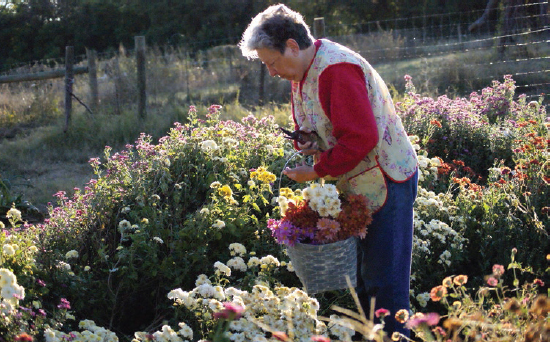
Cool chrysanthemums can be easily rooted from old gardens, cemetery flowers, or the grocery store. Here, my mother gathers a bunch of flowers.
On another occasion, walking through a rough part of Charleston, South Carolina, I stopped to photograph this gorgeous, salmon-tinted crinum growing to the side of an abandoned house. I desperately wanted a piece of it, but standing on a tight little street under the interstate, I could feel eyes tracking me and dogs barking at me, so I kept my camera close and didn’t make a fool of myself by trying to dig. Just then a tall, thick twenty-something neighborhood ambassador slid off his porch, in pajama pants and flip flops, and asked in creole, “Wuh u doin’?” I told him I was just taking a picture of the lily, and he replied, “Ah gotta’ luly. Wanna see my luly?” The only polite thing to do was to follow him to the back of the house to his pride, an enormous patch of red canna lilies. We talked about bug issues, and I took his picture and some canna roots he dug up for me. He later led me to an abandoned housing project where I found yet another crinum lily that I hadn’t seen before.
Bill Adams, who first introduced me to Crinum ‘Pink Trumpet’, roamed backroads and never hesitated to stop and ask for plants. Here he holds up healing squash.
Inside a demolition area, tractors lined up for a Monday razing, I saw a unique, pale pink crinum lily flowering in the shade of a live oak. Again, after digging there, those few bulbs became a mass planting, became rows in the field, got tested in various garden settings, and sent out to experts to name. It’s a common hybrid, but an unusual variation that we now call “Mo’ Pon”; the nonsensical-sounding name came from the first place I did a mass planting of this spectacular shade bulb, under cypress trees along the muddy shore of a place called Moore Pond. The name is a tribute to the pond’s owner, a southern gentleman whose accent turned those words into “Mo’ Pon.”

‘Pink Trumpet’ crinum in a vase. This plant came to me as an unknown. Waiting, watching, and searching for the real name of a plant show respect for the original breeder.
Getting plants and getting names are different things, though. In our nursery world, names matter. It would be unethical and unprofessional of me just to take a found plant and immediately give it a name. I spend years asking around before I put a name on something, which has saved me in the past. Once, Bill Adams, friend and fellow plant scavenger, brought a box of giant crinum bulbs to me. I grew what became the largest, tallest, most stately crinum I’d ever seen. It was a plant I wasn’t familiar with, with flowers 7 inches long hanging from 5-foot-tall stems. As is always my first step in identifying something that I can’t find in any books, I sent pictures to a colleague, who was able to name it right away. ‘Pink Trumpet’ was the creation of one of my crinum mentors, in south Georgia, who sold it locally at his garden center, hundreds of miles from me. I was glad I asked. At home, you don’t really have to worry about proper names like we do in the nursery business.
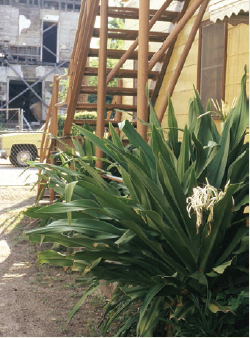
Crinum asiaticum under the steps in Charleston, South Carolina.
I keep a stock of scavenged perennials, especially chrysanthemums, that I can use in gardens and landscapes. Clients like the stories that go with them, the connection to my mentors like Ruth, Bennett, and Gloria, and they like (and I like) plants that used to be cool. Plant trends, as with fashion, music, and technology, change more quickly these days. Plants come in and out of our lives more frequently. These changes used to be based more on improvements: better, shorter, pinker, and taller varieties would replace those that came before. Today, plant trends come and go based on marketing, promotions, and consumerism. And if you’re always buying, you’re going to have to eventually throw things away. Lots of plants are too good for that, no matter how sexy the ad for the new plant.
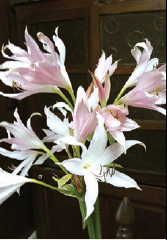
Crinum “Mo’ Pon” is pale pink in part shade.
Us urban collectors have a different set of rules; the mean streets of the city demand it. We employ a few guerilla warfare tactics, cause that’s how we roll, yo. Before you head out to collect, make sure you are geared up for the adventure:
Now that we have the appropriate gear, let’s talk about where to collect plants. In the city, we don’t have a lot of wilderness harboring yet-to-be-discovered varieties. More likely, we have abandoned lots and buildings, sidewalk cracks, parking lots, and the like. Of course, we also have neighbors, public buildings, and city plantings. Yet all of these properties were or are owned by someone, so how do you know what is okay to take? I’ve created a list using stoplight technology to guide you in your collection efforts. Keep in mind that these are guidelines, not the final word, and certainly not legal advice. Know the laws in your community!
RED LIGHT |
YELLOW LIGHT |
GREEN LIGHT |
Digging up plants from your neighbor’s yard |
Taking a single, non-damaging cutting from your neighbor’s yard |
Asking your neighbor for a cutting, division, seeds, etc. |
Taking plants from places of business |
Taking plants from beds of empty office buildings |
Taking a cutting or gathering seeds from an empty office building |
Taking all of the plants from an abandoned lot |
|
Taking one or two plants, cuttings, or seeds from an abandoned lot |
Taking plants from a city planting |
Taking one or two non-damaging cuttings from a city planting |
Taking seeds from a city planting (non-damaging) |
Taking plants that are for sale at the store |
Picking up pieces of plants that have fallen on the floor and are no longer a part of saleable merchandise |
Asking the clerk if you can have said pieces of plants that have fallen to the floor |